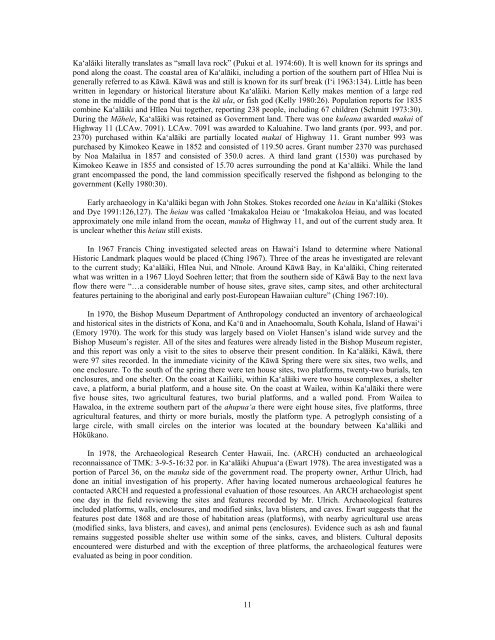Honu'apo Park Resource Management Plan
Honu'apo Park Resource Management Plan
Honu'apo Park Resource Management Plan
Create successful ePaper yourself
Turn your PDF publications into a flip-book with our unique Google optimized e-Paper software.
Ka‘alāiki literally translates as “small lava rock” (Pukui et al. 1974:60). It is well known for its springs and<br />
pond along the coast. The coastal area of Ka‘alāiki, including a portion of the southern part of Hīlea Nui is<br />
generally referred to as Kāwā. Kāwā was and still is known for its surf break (I‘i 1963:134). Little has been<br />
written in legendary or historical literature about Ka‘alāiki. Marion Kelly makes mention of a large red<br />
stone in the middle of the pond that is the kū ula, or fish god (Kelly 1980:26). Population reports for 1835<br />
combine Ka‘alāiki and Hīlea Nui together, reporting 238 people, including 67 children (Schmitt 1973:30).<br />
During the Māhele, Ka‘alāiki was retained as Government land. There was one kuleana awarded makai of<br />
Highway 11 (LCAw. 7091). LCAw. 7091 was awarded to Kaluahine. Two land grants (por. 993, and por.<br />
2370) purchased within Ka‘alāiki are partially located makai of Highway 11. Grant number 993 was<br />
purchased by Kimokeo Keawe in 1852 and consisted of 119.50 acres. Grant number 2370 was purchased<br />
by Noa Malailua in 1857 and consisted of 350.0 acres. A third land grant (1530) was purchased by<br />
Kimokeo Keawe in 1855 and consisted of 15.70 acres surrounding the pond at Ka‘alāiki. While the land<br />
grant encompassed the pond, the land commission specifically reserved the fishpond as belonging to the<br />
government (Kelly 1980:30).<br />
Early archaeology in Ka‘alāiki began with John Stokes. Stokes recorded one heiau in Ka‘alāiki (Stokes<br />
and Dye 1991:126,127). The heiau was called ‘Imakakaloa Heiau or ‘Imakakoloa Heiau, and was located<br />
approximately one mile inland from the ocean, mauka of Highway 11, and out of the current study area. It<br />
is unclear whether this heiau still exists.<br />
In 1967 Francis Ching investigated selected areas on Hawai‘i Island to determine where National<br />
Historic Landmark plaques would be placed (Ching 1967). Three of the areas he investigated are relevant<br />
to the current study; Ka‘alāiki, Hīlea Nui, and Nīnole. Around Kāwā Bay, in Ka‘alāiki, Ching reiterated<br />
what was written in a 1967 Lloyd Soehren letter; that from the southern side of Kāwā Bay to the next lava<br />
flow there were “…a considerable number of house sites, grave sites, camp sites, and other architectural<br />
features pertaining to the aboriginal and early post-European Hawaiian culture” (Ching 1967:10).<br />
In 1970, the Bishop Museum Department of Anthropology conducted an inventory of archaeological<br />
and historical sites in the districts of Kona, and Ka‘ū and in Anaehoomalu, South Kohala, Island of Hawai‘i<br />
(Emory 1970). The work for this study was largely based on Violet Hansen’s island wide survey and the<br />
Bishop Museum’s register. All of the sites and features were already listed in the Bishop Museum register,<br />
and this report was only a visit to the sites to observe their present condition. In Ka‘alāiki, Kāwā, there<br />
were 97 sites recorded. In the immediate vicinity of the Kāwā Spring there were six sites, two wells, and<br />
one enclosure. To the south of the spring there were ten house sites, two platforms, twenty-two burials, ten<br />
enclosures, and one shelter. On the coast at Kailiiki, within Ka‘alāiki were two house complexes, a shelter<br />
cave, a platform, a burial platform, and a house site. On the coast at Wailea, within Ka‘alāiki there were<br />
five house sites, two agricultural features, two burial platforms, and a walled pond. From Wailea to<br />
Hawaloa, in the extreme southern part of the ahupua‘a there were eight house sites, five platforms, three<br />
agricultural features, and thirty or more burials, mostly the platform type. A petroglyph consisting of a<br />
large circle, with small circles on the interior was located at the boundary between Ka‘alāiki and<br />
Hōkūkano.<br />
In 1978, the Archaeological Research Center Hawaii, Inc. (ARCH) conducted an archaeological<br />
reconnaissance of TMK: 3-9-5-16:32 por. in Ka‘alāiki Ahupua‘a (Ewart 1978). The area investigated was a<br />
portion of Parcel 36, on the mauka side of the government road. The property owner, Arthur Ulrich, had<br />
done an initial investigation of his property. After having located numerous archaeological features he<br />
contacted ARCH and requested a professional evaluation of those resources. An ARCH archaeologist spent<br />
one day in the field reviewing the sites and features recorded by Mr. Ulrich. Archaeological features<br />
included platforms, walls, enclosures, and modified sinks, lava blisters, and caves. Ewart suggests that the<br />
features post date 1868 and are those of habitation areas (platforms), with nearby agricultural use areas<br />
(modified sinks, lava blisters, and caves), and animal pens (enclosures). Evidence such as ash and faunal<br />
remains suggested possible shelter use within some of the sinks, caves, and blisters. Cultural deposits<br />
encountered were disturbed and with the exception of three platforms, the archaeological features were<br />
evaluated as being in poor condition.<br />
11


